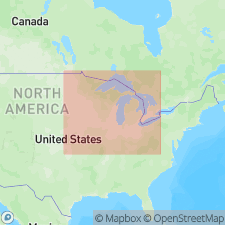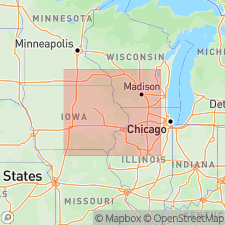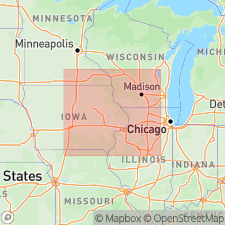
- Usage in publication:
-
- Mankato
- Modifications:
-
- Overview
Summary:
Pg. 51-53. Proposed Hudsonian substage for late Wisconsin, Quebecan substage for middle and early Wisconsin, and Manitoban substage for Iowan, and included Peorian loess and Iowan drift in his Wisconsin stage, thus treating the Wisconsin as the 4th glacial stage, instead of the 5th.
Source: US geologic names lexicon (USGS Bull. 896, p. 1282-1283).

- Usage in publication:
-
- Mankato
- Modifications:
-
- Principal reference
Leighton, M.M., 1933, Naming the subdivisions of the Wisconsin glacial age: Science, v. 77, p. 168.
Summary:
Withdrew his names Hudsonian, Quebecan, and Manitoban, and divided his Wisconsin "age" into Mankato (late Wisconsin), Cary (middle Wisconsin), Tazewell (early Wisconsin), and Iowan. The name Mankato was taken from Mankato, Minnesota, "where the late Wisconsin deposits are excellently displayed"; the name Cary was from a town in McHenry County, northeastern Illinois, "where the middle Wisconsin deposits are well displayed"; and the name Tazewell from Tazewell County, Illinois, "where the early Wisconsin deposits are well shown in their relations to underlying Peorian loess."
Source: US geologic names lexicon (USGS Bull. 896, p. 1282-1283).

- Usage in publication:
-
- Mankato
- Modifications:
-
- Not used
Summary:
In Feb. 10, 1933, issue of Science, there appears a brief article by Dr. M.M. Leighton on "The naming of the subdivisions of the Wisconsin glacial age," in which he proposes the substitution of certain meainingless terms -Tazewell, Cary, and Mankato- for the significant terms, Early Wisconsin, Middle Wisconsin, and Late Wisconsin, which have been in general use for considerable time and are readily understood by anyone reading geological literature, denoting as they do successive parts of the Wisconsin glacial stage. The incentive for suggesting the new names seems to have its basis in a newly acquired view of Dr. Leighton that the deposition of the Iowan drift came only a short time before that of the Early Wisconsin drift, and so it may properly be included in the Wisconsin stage.
Whether Iowan should be so included, if the entire field is taken into account, is far from being clearly established. This has been made forcibly apparent in a recent report by Dr. W.C. Alden on eastern Montana and adjacent areas (USGS Prof. Paper 174, 1932). There are deposits in Montana and the Dakotas which Dr. Alden is inclined to refer to the Iowan, but he considers them too old to be included in the Wisconsin stage. These are discussed by him under the heading "Illinoian or Iowan." But he thinks they do not appear to be as old as the Illinoian of Illinois.
Inasmuch as the entire series of drifts classed as Illinoian, Iowan, and Wisconsin fall in the last quarter of the Pleistocene the distinction in age aspects are less striking than between these drifts and those of middle and early Pleistocene age, known as Kansan and Nebraskan. This being the case, it seems advisable to let the terms that are in general use stand, especially where they have significance, and are self-explanatory, and not replace them by a set of meaningless terms.
Source: US geologic names lexicon (USGS Bull. 896, p. 1282-1283).
For more information, please contact Nancy Stamm, Geologic Names Committee Secretary.
Asterisk (*) indicates published by U.S. Geological Survey authors.
"No current usage" (†) implies that a name has been abandoned or has fallen into disuse. Former usage and, if known, replacement name given in parentheses ( ).
Slash (/) indicates name conflicts with nomenclatural guidelines (CSN, 1933; ACSN, 1961, 1970; NACSN, 1983, 2005, 2021). May be explained within brackets ([ ]).

